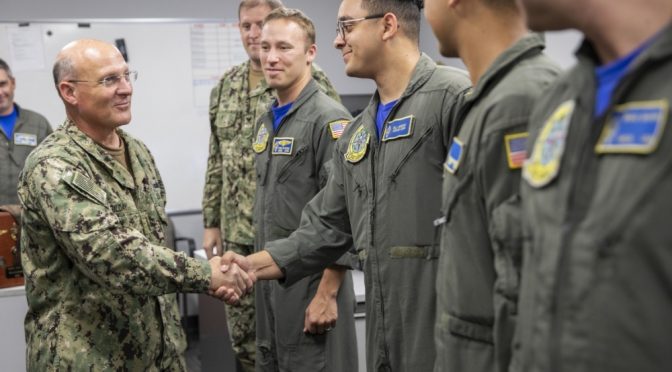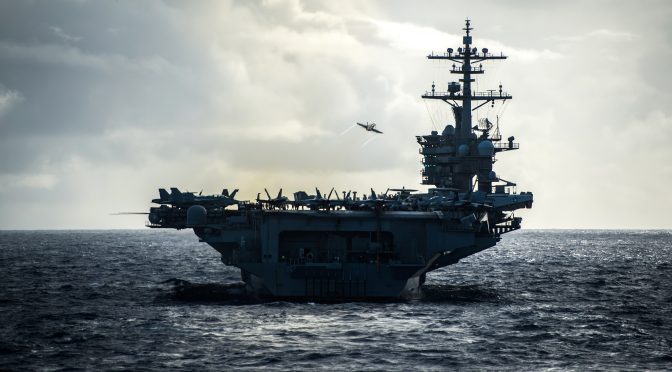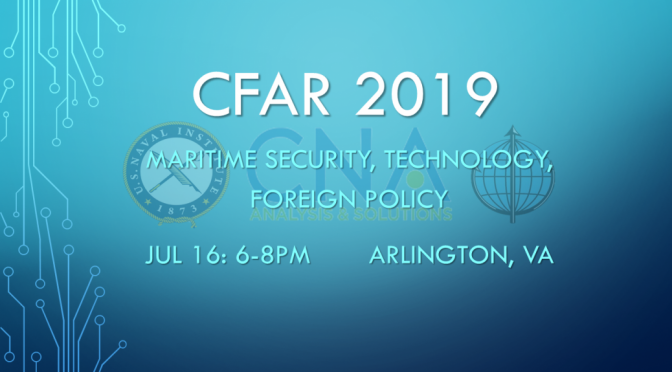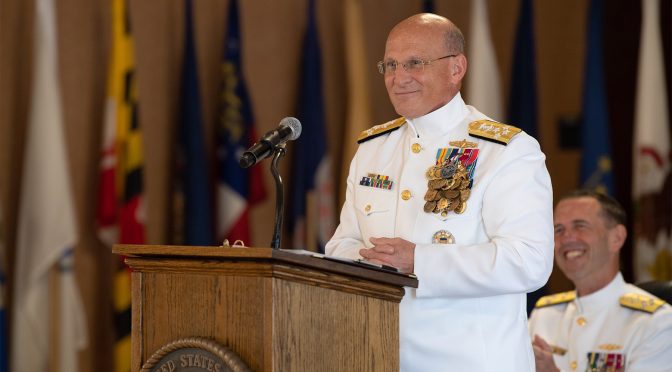The following is adapted from remarks delivered at the annual CIMSEC Forum for Authors and Readers, covering the “How the Fleet Forgot to Fight” article series.
By Dmitry Filipoff
The article series covered many topics so I’ll try to narrow it down and focus on what I feel are some of the more important points.
When those two major reviews came out to try to explain why those fatal collisions happened out in the Pacific, one term that got used to describe how the Navy went wrong was the “normalization of deviation.” And this term is the main theme behind this article series, that the Navy is suffering from very serious self-inflicted problems and is deviating in many of its most important efforts in how it prepares for war.
What specifically inspired these articles was writing published in Proceedings. Specifically, writing on the new Fleet Problem exercises by Pacific Fleet commander Admiral Scott Swift, and also writing by the Pacific Fleet intelligence director, Captain Dale Rielage, especially an article of his called “An Open letter to the U.S. Navy from Red.” These articles helped spark the series because of how they describe the character of the Navy’s exercises. And given the incredible importance that military exercises have, this issue really sheds light on systemic problems throughout the Navy.
When looking into the Navy’s major exercises, the keywords and themes that kept coming up were traits such as high kill ratios, training one skillset at a time, poor debriefing, and weak opposition.
The structure of training certification in the Navy usually took the form of focusing on individual skillsets and warfare areas – anti-surface warfare and anti-air warfare, and so on. But these things were not often combined in a true, multi-domain fashion. Instead, exercise and training certification regimes often took the form of a linear progression of individual events.
Opposition forces were made to behave in such a way as to facilitate these events. However, a more realistic and thinking adversary would probably employ the multi-domain tactics and operations that are the bread and butter of war at sea. But instead the opposition often acted more as facilitators for simplistic target practice it seems, which is why very high kill ratios were the norm. But more importantly, a steady theme that kept reappearing was that the opposition pretty much never won.
There are so many of these events, so many training certifications that had to be earned in order to be considered deployable that Sailors feel extremely rushed to get through them. And these severe time pressures help encourage this kind of training.
If you are losing and taking heavy losses then you should be taking that extra time to do after action reviews and extensive debriefing to figure out what went wrong, how to do better, and understand why in real war your mistakes would’ve gotten your people killed. The way this kind of conversation plays out is fundamental to the professional development of the warfighter, and it is an important expression of the culture of the organization.
When it comes to debriefing culture within the Navy’s communities you can see a difference in the strike-fighter community, where candid debriefing is a more inherent part of the way they do business, but the opposite was very much true of the surface Navy’s system. And what is being described here also applies more broadly to how things were done for larger groups of ships such as at the strike group level.
But overall the Navy’s major exercises often took a scripted character, where the outcomes were generally known beforehand and the opposition was usually made to lose. Training only one thing at a time against opposition that never wins barely scratches the surface of war, but for the most part this was the best the Navy could do to train its strike groups for years.
So is this common? It looks like all the services have done heavily scripted exercises to some degree, but there is a major difference between what the Navy was doing, and what the Air Force and the Army have been doing for a long time.
Unlike the Navy, the Army and Air Force have true high-end training events that they rotate their people through. For the Air Force this is a major exercise called Red Flag, and for the Army this happens at the National Training Center. They compete against opposition forces that often inflict heavy losses and employ a variety of assets simultaneously. Those forces are composed of units that are dedicated toward acting as full-time opposition for these events, such as the 11th Armored Cavalry Regiment, where units across the Army rotate through the National Training Center to face off against them specifically. The job of these standing opposition forces is to learn and practice the doctrine of foreign adversaries, and then put that into practice at these events to make for a more realistic fight.
But by comparison it seems the Navy doesn’t have a major standing formation to act as full-time opposition for the high-end fight. And as far as the Marines go, it looks like they have a history of issues that more closely resembles that of the Navy’s.
Now when it comes to the Chinese Navy, those public reports that the Office of Naval Intelligence puts out on foreign militaries paint a very different picture from what the U.S. Navy was doing. The Chinese Navy often trains multiple skillsets at a time, they do not always know the composition and disposition of the opposing forces they are facing off against, and they do not always know exactly what will happen when the event is about to go down.
They’ve been training like this for some time now, and with a specific emphasis on high-end warfighting at the very same time the U.S. Navy was focusing on the low-end spectrum of operations. The Chinese Navy has been focused on learning the more lethal skillset. So in very important respects, the Chinese Navy has been training much harder than the U.S. Navy for years.
Recently there have been some major changes for the U.S. Navy. There are the Fleet Problem exercises Admiral Swift started which seem to be the first consistent and truly challenging high-end exercise events the Navy has had in decades. The COMPTUEX exercise ships do before deploying is becoming more difficult, but through more virtual augmentation. The Surface Navy is going through these SWATT exercises which are now some of the most advanced events surface ships experience before integrating with strike groups.
But what all of these changes have in common is that they only began around two or three years ago. The extent to which the Navy will make the most of them is uncertain. What is clear however is that the corporate memory of the modern U.S. Navy is still heavily shaped by decades of quite unrealistic training.
But exercises go far beyond training. At the tactical level, they are the one activity that comes closest to real war. So exercises are supposed to play a vital function as proving grounds for all sorts of concepts, ideas, and capabilities. This goes to the very heart of one of the most important missions of a peacetime military, which is to develop the force for future conflict. The Navy’s exercise shortfall is far more than an issue of operator skill, it is a sweeping developmental problem.
Consider how you could go about exploring a new tactic, a wargame, or an operating concept. You come up with an idea, and refine it as much as possible through simulations or other methods. And then you finally try it out in the real world through an exercise. You make sure to use serious opposition to see where things may go wrong or backfire. You then rinse and repeat until you have a sturdy, resilient concept. And once you have that, you convert lessons learned in that experimentation into new training, you update the training events, and then rotate your people through those events so they have a chance to learn and apply the new thing.
But this isn’t how force development worked in the U.S. Navy.
When it comes to at-sea experimentation, relatively few warfighting ideas were ever tried in the real world to begin with. But if an idea managed to get tested in some sort of combat exercise it often went up against heavily scripted opposition. As a result, it had few (if any) rounds of trial and error.
But if they moved on in spite of that, the idea was perhaps turned into some publication that was then tucked away in a doctrine library somewhere. And there it’ll sit among many other publications that hardly anyone is really familiar with.
But if they do happen to be familiar with it, they will not often have the chance to actually practice it and learn it in a live training event. But if they do have the chance to actually practice it, it most likely turned into just another check-in-the-box scripted certification event, lost among the dozens if not hundreds of other certification events that are all competing with each other for the time of the extremely busy Sailor. And the Sailors have no real choice but to rush through them and cut corners just to make due and get out on time for deployment.
What’s important to understand is that training is what makes force development stick. Training is what establishes that final connection between the skill of the deckplate Sailor, and all these warfighting concepts that are allegedly trying to evolve the force.
But so much of what the Navy did for force development didn’t go far because this habit of unrealistic exercising and this overflowing training certification system combined to doom so many warfighting concepts to being untested, unrefined, and untaught.
For another important example on why training has to be linked with other parts of force development, you can look to the Navy’s wargaming enterprise. These wargames are really important to how the Navy thinks about the future, and among many things these wargames can inform war planning. But if you read more into it, these wargames aren’t nearly as scripted or as easy as the training events, and the fleet often takes very serious losses in these wargames. Especially against China.
So what could be the implications of having a large disparity between the realism of training and the realism in wargaming? For one, it means the war plans the United States has drawn up for great power conflict are filled with tactics and operations for which the U.S. Navy has made barely any effort to actually teach to its people. To paraphrase a certain Defense Secretary, you go to war with the fleet you trained, not the one you wargamed.
Another major implication of the exercise shortfall was in how the Navy applied strategy to operations, or what the fleet was doing on deployment all these years. The Navy not only has the opportunity to work on force development within the work-up cycle, but also once ships are out on deployment. However, once ships deployed, their operations were mostly focused on missions that contributed little in the way of developing the fleet.
It should be remembered that many of the low-end power projection missions that dominated Navy deployments during these past few decades, things like security cooperation, presence, and maritime security, were at first not seen as overriding demand signals for the Navy’s time. The strategy and policy documents the Navy was putting out just after the Cold War ended characterized the opportunity to do these missions as a luxury, one that was afforded to the Navy only through the demise of a great power competitor.
When it comes to the major campaigns the U.S. was involved in these past few decades, mainly Iraq and Afghanistan, what needs to be understood is that blue water naval power struggles to find relevance in these kinds of wars. A destroyer or a submarine can hardly do much to fight insurgencies or nation-build. So for the vast majority of the fleet’s ships they usually had to find other things for them to do with their time, including numerous missions that were certainly helpful but often optional.
But because blue water naval power just cannot do much for counterinsurgency and nation-building campaigns, in the past twenty or so years of insurgent wars, if any of the services could have made the time to work on itself, it is the Navy.
In spite of their own crushing operational tempos the other services made sure to guarantee a large amount of time and forces for large-scale exercise events. Every year, hundreds of aircraft rotate through the Air Force’s Red Flag exercise, and a full third of the Army’s active duty brigades rotate through the National Training Center.
Compared to this the Navy is very different. It looks like for the past few decades the Navy has been spending almost all of its ready naval power on what the combatant commanders want.
So as the Navy looks to strike a new balance between spending its time on force development versus forward operations, this should be seen as an opportunity for the Navy to finally reclaim some of the fleet for itself, to devote ready naval power toward working on the Navy’s agenda and not just what combatant commanders want.
For example, the Navy will soon be standing up a surface development squadron that is exclusively focused on experimenting for force development. That is an example of guaranteeing time and ready naval power to be spent on solving Navy problems.
But overall, the Navy as an institution hardly recognizes force development as a major driver of fleet operations. Things like trying out wargames and concepts of operation in the real world must be recognized as some of the strongest possible demand signals for the Navy’s time and forces. So as the Navy reconfigures itself for great power competition it has to think about how it will strike a new balance between spending time on forward operations, versus spending time on working on itself.
The fleet can start with the strategic guidance the Navy has to align itself with. There is a new national defense and national security strategy that officially make great power competition the main priority. There is a mandate from the Chief of Naval Operations, for high-velocity learning, to learn better and faster. So what does the Navy need to learn about in an era of great power competition? A large part of that is high-end warfighting. So the Navy needs to identify what specific things have the most learning value when it comes to getting better at that specific problem set.
Look at the learning value of a Fleet Problem or a SWATT exercise, and compare it to maritime security missions or doing security cooperation with a third world nation. It should become plainly clear that these exercise events can teach the Navy far more about high-end warfighting than almost any forward operation.
Some might say the Navy actually did work on itself in forward operations through exercising with numerous partners and allies. But the U.S. Navy often does not like sharing even moderately classified information with those partner fleets. This greatly limits the willingness of the Navy to flex its capability in front of partners abroad. There is also a lot of wariness over being watched by others when exercising in forward areas.
And this is one of the major arguments that gets frequently raised about why the Navy shouldn’t do these exercises as much, that great power competitors are watching.
However, this is the modern state of competition. Great power competitors have their own satellite constellations, and they are hacking into your systems every single day, and they already know all kinds of things about you that you’d rather they not know. But this kind of heightened transparency between great power militaries is the new status quo. And for what it’s worth, when it comes to their exercises the Chinese realize they are being watched all the time but that doesn’t seem to be stopping them as much.
If the fact they are watching is enough to stop you from doing these events, then you will have allowed them to deter you from carrying out a vital learning experience. And if your forces are pushing hard in these exercises and defeating some serious opposition while competitors watch, then that could end up deterring them and working in your favor. But if they do happen to learn something from spying on your training then at least recognize that one thing they can never hack or steal is the skill of the warfighter.
What the Navy has to do is break away from this tunnel vision-like focus it has had on forward operations for these past few decades, and do more to feed the colossal demand signal that is coming from the needs of force development. There are two elements that can drive this demand signal. One is the force development of competitors, and the other is the ever-evolving nature of disruptive capability surprise.
Looking at China, it is critical to understand that the Chinese military is an organization that is completely focused on its force development. They have no significant overseas operations that draw their attention elsewhere. And you can see the aggressiveness of their force development in the scale of their reforms. A few years ago they overhauled their theater command structure, created a new branch in the form of the Strategic Support Force, and cut several hundred thousand troops to shrink the size of the force for more even modernization. So it is important to recognize that the Chinese Military has made sure to retain enough decision space to make significant changes to its force development.
Looking at the Chinese Navy today, because their force has very few overseas commitments, the operating posture of their fleet has far more in common with the interwar period U.S. Navy than the modern U.S. Navy does. This can make them quite dangerous, because like the interwar period U.S. Navy (the Navy that would of course go on to win WWII) their operating posture allows them to spend most of their time on working on themselves.
Going to a second major demand signal of force development, that is disruptive capability surprise. Look at WWI, the machine gun, the trench, and big-gun artillery. When they finally put all these new capabilities together, it created a type of warfare that nobody had really seen before. Because of new technology the nature of tactical success had changed so much, but their peacetime force development failed to detect that. The surprise that came from those new weapons and the deadly tactics they produced was so disruptive that it ripped apart the operational and strategic plans of nations caught in great power war.
So how to get a sense of that burden, of how much real-world experimentation needs to go into modern force development? Look to how networked combat between great power militaries has never happened before, or how fleet combat between great powers hasn’t happened since WWII. Look at everything that’s evolved since then. Electronic warfare, cyber, missiles, satellites, so much has changed, and our ability to truly know how all of that will actually come together to produce specific tactical dynamics and winning combinations is very difficult to know for sure.
Exploring the cross-domain nature of modern warfighting will be fundamental to understanding this problem. Consider the battleship, how if something is set up to where it’s gun line versus gun line, battleships will rule those engagements. But once other platforms are included, platforms that can act through other domains such as carriers, submarines, and land-based air, you can start to see how the tactics of one can rule out the tactics of another. So how could modern cross-domain interactions play out and reveal what’s decisive? This will drive up the resource burden for force development since it will demand experimenting with many different kinds of opposition at the same time, such as joint forces.
A lot of these questions are already being looked at by organizations within the Navy, but the furthest the analysis is able to go is often limited by virtual simulations. Some months ago we published an excellent piece on CIMSEC where people from the Naval Postgraduate School, mainly wargamers and operations research folks, discussed doing tens of thousands of simulations and models to discover tactics and operating concepts for a new unmanned surface ship. Those kinds of people certainly learn a lot about new tactics. But they will also tell you that they are absolutely craving more real-world experimentation.
Even so, it is still not enough to do realistic warfighting experiments and simulations. What is necessary is the candor and the will to act on their results, and the understanding that if a weapon is failing in the context of its application, then recourse must come through innovating its tactics. And if no tactical innovation can preserve a weapon’s utility, then it must be discarded. However, all the services and not just the Navy have some history of scripting their wargames and exercises in order to satisfy preexisting prejudices. But the politics of programmatics, the industrial base, and service identity should never be allowed to trump responsible force development. What is programatically comfortable today can easily cost lives and wars tomorrow.
Whether it be the Navy’s paltry offensive firepower, its seriously degraded surge capacity, or poor standards for its vaunted Aegis combat system, the fleet is in dire need of course corrections. Now the U.S. Navy finds itself locked in great power competition against a rising maritime superpower, but only major change can ensure the American fleet will still command the seas.
Dmitry Filipoff is CIMSEC’s Director of Online Content. Contact him at [email protected].
Featured Image: PACIFIC OCEAN (Aug. 4, 2018) – An F/A-18E Super Hornet takes off from the flight deck of the aircraft carrier USS Carl Vinson (CVN 70). (U.S. Navy photo by Mass Communication Specialist 2nd Class Devin M. Langer/Released)




